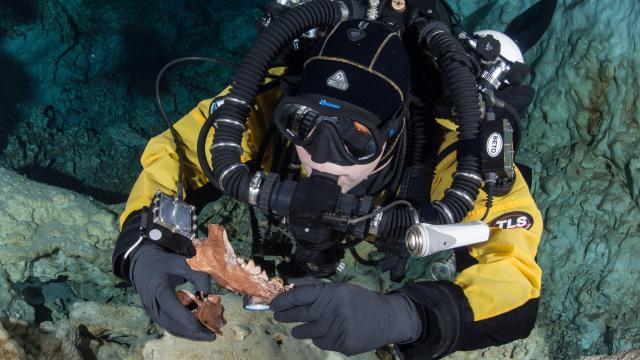Bones from an extinct short-faced bear and a wolf-life carnivore are among the many fascinating remains pulled from a submerged cave in Mexico. The discoveries provide a glimpse into the kinds of animals that lived in Central America during the last Ice Age.
For paleontologists, Central America’s Late Pleistocene period is a bit of a blindspot; animal bones don’t preserve well in tropical environments. This murky period of ecological history, however, is now considerably clearer thanks to the efforts of an East Tennessee State University research team led by paleontologist Blaine Schubert.
The scientists have completed their examination of various bones pulled from an underwater cave in Mexico’s Yucatán Peninsula, the findings of which are now providing new insights into the ecological shifts that took place in the area, and the animals—and even humans—who lived in Central America during the Late Pleistocene. The new research was published this week in Biology Letters.
The new paper focused on bones pulled from Hoyo Negro, a submerged pit located inside the Yucatán’s Sac Actun cave system. Hoyo Negro, meaning “black hole” in Spanish, consists of three submerged horizontal passages approximately 12 meters (40 feet) below sea level that are accessible to divers. This pit only became flooded after the end of the last Ice Age, around 9,800 years ago. Prior to that, however, the holes were a death trap. Unsuspecting animals, and even humans, who ventured into the dark cave system sometimes fell into the pit, where they perished. Fortuitously for scientists, however, the eventual flood waters resulted in a tranquil, low-oxygen environment that preserved the bones.
Using radiocarbon dating, the ETSU researchers dated the various bones pulled from the submerged cave to between 38,400 and 12,850 years ago. This date range includes a healthy portion of the last Ice Age and the final stage, or terminal boundary, of the Late Pleistocene, when the massive glaciers were melting in earnest.
The researchers identified several extinct species, including some thought to be exclusive to South America. Two impressive specimens were the skull of Arctotherium wingei—a 150-kilogram (330-pound) short-faced bear—and the bones of Protocyon troglodytes, a carnivorous wolf-like animal. The remains of these two species were pulled from Hoyo Negro several years ago and misidentified, but the new paper has corrected these initial errors, as Live Science reports.
“This discovery expands the distribution of these [carnivores] greater than 2,000 km [1,200 miles] outside South America,” wrote the authors in the new study, which suggests “a more complex history of these organisms in Middle America.”
In addition, the researchers identified multiple ground sloth species (including the newly described Nohochichak xibalbahkah), tapirs, sabertooth cats, cougars, elephant-like gomphotheres, bears, and dog-like animals.
Back in 2007, researchers working in the same submerged cave discovered a relatively complete human skeleton dating to between 13,000 and 12,000 years ago. In previous work, researchers were able to extract important genetic information from the remains. The human skeleton belonged to an adolescent female who likely fell into the hole and died. The new study now adds to our knowledge of the kinds of animals this human and her compatriots likely interacted with during this time period.
The new paper is also adding to our understanding of the Great American Biotic Interchange (GABI)—a fancy phrase describing the intermingling of plants and animals between North and South America. These two continents weren’t always connected, but when that momentous event finally happened—after the formation of the Isthmus of Panama—the floodgates were opened for animals to venture back and forth between the two land masses. GABI began around 3 million to 2.5 million years ago, and it’s characterised by four major pulses—important ecological shifts that occurred 2.5 million years ago, 1.8 million years ago, 800,000 years ago, and 125,000 years ago.
“These pulses overlap with glacial episodes, sea-level lowering, widening of the isthmus and more-open habitats that would have created opportunities for dispersal of large mammals adapted to open habitats,” wrote the authors in the new study. An exciting idea proposed in the new paper is the presence of a fifth pulse, which happened at, and as a result of, the end of the last Ice Age. This glacial pulse “would have caused similar landscape changes and migration opportunities” as the previous four pulses, but unlike earlier exchanges, the fifth pulse “involved humans and culminated with the mass extinction of most American megafauna, including Arctotherium and Protocyon,” according to the new study.
Fascinating stuff, and also very humbling. The first people to reach Central America faced no shortage of threats, from fearsome carnivores to gaping, unseen holes.
